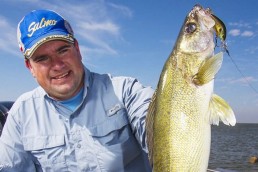Early-season Checklist for Walleyes
SHARE THIS POST
For many walleye anglers across the Upper Midwest, some of the first open-water walleye fishing opportunities occur on systems like the Wolf, Missouri, Mississippi and Rainy rivers, to name a few. While each can have specific nuances that make it unique, river walleyes also follow some of the same general rules regardless of where they swim; how fish relate to current and set up on current seams is universal.
Here are guidelines for narrowing down the hunt for river walleyes in the early season.
1. The trump card
Look for the right color—the water’s color is the trump card. Incoming tributaries and culverts are prime locations for finding spring walleyes on river systems. This incoming current is often warmer and there are washout holes, channels and current seams where fish rest. High water can cause turbidity in the water and can contain debris. Some incoming tributaries have more turbidity than others after rapid snowmelt or a spring rain. In some cases, you might have to move upstream from the incoming tributary because the water is too dirty. Use your prop to gauge water clarity. If you can see your prop, the fish won’t have any problem finding your presentation. If you can only see a few inches into the water, spend a good part of your day looking for cleaner water. Pockets of cleaner water will produce better fishing when rivers get muddy.
2. Fake it ‘til you make it
Soft plastics and hair usually out-fish other baits. We all know a jig and minnow catches a lot of spring walleyes, but soft plastics and hair can catch even more. As your jig sweeps by fish in the current, these fish don’t have much time to react to or scrutinize a presentation. The added durability is part of what makes both classic bucktail hair jigs and soft plastics so effective. When you miss a fish with a jig and minnow and the fish steals that minnow, you’re done. You must re-hook the bait, and there is dead time where you are not effectively presenting your presentation. Soft plastics, bucktail hair jigs or marabou jigs keep you in the water longer. For moderate current, Kalin’s Sizmic Grubs work well, while a slimmer, more streamlined profile like the Kalin’s Jerk Minnow JR works better in stronger current.
Are you enjoying this post?
You can be among the first to get the latest info on where to go, what to use and how to use it!
3. The bait debate
There are situations where you better have water in the baitwell. There are also times when minnows are needed and it typically coincides with slower current, and tougher bite conditions. Much of the time we find most fish close to the current seam where they are aggressive in the faster waters and the rest of the fish are closer to the seam. But there are times when fish will move away from current entirely and set up in backwater areas during high water or warmer dead-water pockets behind sandbars and other current obstructions. This is where a classic jig and minnow shines.
4. Angle of the dangle
When slipping the current, the old rule of thumb was to keep the boat the same speed as the jig getting swept downriver; you wanted to keep your line vertical. This is one vital page from the playbook and we have seen where you wouldn’t get bit if the line wasn’t vertical to a jig. However, there are other plays to have in your bag of tricks as it can be downright amazing how river fish respond to different presentations. Dragging jigs upstream or downstream can be deadly and dragging can often put a lot of fish in the boat when traditional slipping presentations that keep the jig right below the boat don’t work. These dragging tactics shine in less than 10 feet where there is moderate to slow current, which is where you’ll find walleyes each spring. For dragging downstream, lighten up the jig and give your jig a good cast upstream. Let the current carry you downstream with the jig dragging upstream behind the boat. If you can’t keep the jig upstream, you don’t have enough weight. The other method is slowly dragging the jig upstream. Again, simply cast behind the boat and use your trolling motor to crawl upstream. You typically want the jig to tick the bottom occasionally. These horizontal jig presentations are catchers on rivers.
5. Cast more this season
Good river holes and deep channels can be hot spots. But the reality with river walleyes is that these deep holes are often where fish winter. As the water warms up, raising the metabolism of fish, the walleyes start swimming against current and moving through the system. These fish will often use much shallower current seams and breaks. Some of the biggest fish now are routinely caught out of shallower water along riprap, clam beds and sandbars where there is less than 10 feet of water. In fact, we catch many big walleyes on rivers each spring in less than 3 feet. You will not only catch these shallow fish by pitching or casting jigs, but you can also fish through so much more water with each cast.
MWO
SHARE THIS POST
Did you enjoy this post?
You can be among the first to get the latest info on where to go, what to use and how to use it!
Jason Mitchell
Jason Mitchell was a top walleye guide on Devils Lake, N.D. for nearly 20 years. Today, Mitchell produces the Jason Mitchell Outdoors TV program. Visit jasonmitchelloutdoors.com for more.



